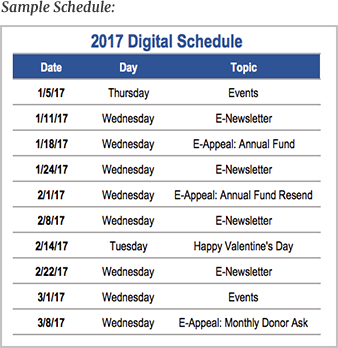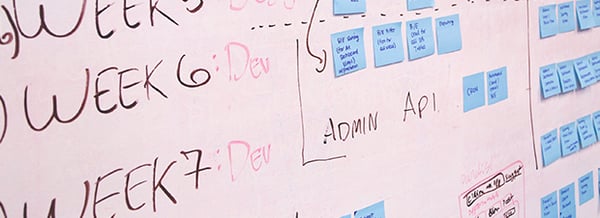
In general, it’s good to outline a year of planned fundraising campaigns and show the rationale for campaigns tied to your program goals for acquisition, renewal and deepening engagement. Whether they are designed to complement direct mail, align with standard fundraising events (e.g. #GivingTuesday) or are just part of regular outreach in your programs, planning is the backbone of direct response.
But organizations that develop a plan and stick to it like super glue may get caught in these scenarios:
Stiffly Scheduled Silos
Sometimes, it’s a natural disaster or heartwarming client story featured in local media that derails the planned marketing and fundraising schedule. And sometimes, leadership or other departments who are so focused on the plan miss seeing the opportunity of a fundraising ask that’s right in front of them.
So when you’re creating that annual schedule, discuss these questions with everyone involved in the plan:
- Is your plan—and workflow—set up to be flexible for a last minute change?
- What are the rules for engagement to negotiate a change of plans? Make sure you understand the benefits and disadvantages of postponing specific messaging types.
- Will senior leadership or the board support a change of plans, especially if it could affect promotion of a “pet project”?
Tip: A strong digital program only works if it’s flexible. You can create an annual roadmap that includes fundraising, email acquisition, web traffic and other goals, but you will limit your success if you aren’t prepared for a few (or several) detours along the way.

Don’t Fear Change
This is not just a measurement of your flexibility. This is whether your annual plan was designed to handle change if it’s not performing.
Ask yourself: Does your plan have additional campaigns you can put into play if the original plan isn’t working?
This is a much harder concept for some aspects of direct response. Direct mail requires much longer lead times than online, so you’re less likely to abandon or change a direct mail strategy in a crunch. But an email can be created and sent same day. Your website, email and social media can all be updated with a few clicks.
The ability to change your online program is one of its greatest strengths. Don’t be afraid to change direction.

In early 2016, a new client’s January email campaigns were not performing as strongly as we predicted. Based on their list size, we anticipated a higher response rate. We reviewed previous email campaigns and found past appeals that had strong responses. Within two months, we had adjusted the original plan and were taking advantage of recent, but often unplanned events, as our fundraising offer. This client ended 2016 with a 146% increase in their email giving.
Changing direction could also mean building on current campaigns and storylines past the pre-planned schedule. Though a schedule might indicate time to change topics, be sure to review the current campaign’s success and evaluate opportunities for the campaign to be further developed.
Our client with the successful 2016 email campaigns had some positive results, in part, because we didn’t always move on to another campaign. In this case, it was a story about animals being rescued from cruelty, that was stirring heartstrings and generating response, so we continued with that story for 2-3 emails.
Tip: Be ready to wipe the planned schedule clean and try something new if the results aren’t hitting the mark. You can take it slow or test into something new, but don’t be afraid to change direction.

Test for Your Future, Not Just Your Best Subject Line
Speaking of testing, your overall plan should include testing design, copy, email subject, campaign ideas and list segmentation. But look to make these tests part of a year-long approach to improving your digital program and not just one-off subject lines with limited learnings.
A 10-10-80 type test is the most popular option, because 80 percent will receive the best version of your email, while the other two groups will see the test emails. However, if that’s your only test approach, you may not learn enough useful information for the next email. Along the way, find out if any of these prove stronger for your email marketing and online fundraising:
- Include personalization in the subject line.
- Use words like “local” or specific city or county names to make the ask sound very close to home.
- Try a variety of layouts that better reflect the campaign.
Note: Not every ask for donations needs to be in letter format!
Tip: Not every online appeal needs to include a test but do plan for regular testing throughout the year. Test in a way that your results get better and better over time.

Imitation… Flattery… and Falling Flat
I believe that in the digital landscape, it’s ok to “borrow” from others. If you like the layout of a web page and think it would be ideal for your content – test it and see what happens. Like the look and copy of the annual fund appeal for another organization? Let’s wait a second.
While most layouts and styles online are fair game to be leveraged, don’t get caught stealing the eye candy without knowing its value. Just because it looks good doesn’t mean it’s performing… or that it will perform well for your organization.
Clients and colleagues often forward emails or send links to websites, and say something like, “Wow, that’s cool. Can we do that?” or “I want this!”. It’s smart to be on the lookout for something new and different but don’t always assume that bright shiny object is your ticket to online fundraiser’s paradise.
Tip: I’ve seen many “plans” go sideways by trying to copy someone else’s strategy or design. It’s ok to test before going all in to redesign your website, donation forms and emails, but keep in mind what you see as “eye candy”, your donors might see as a dud.

Final Thoughts
Digital is meant to be nimble and the best online fundraising is often entirely unplanned. Create a plan … but think of it more like a compass than turn-by-turn directions.





Leave a comment: